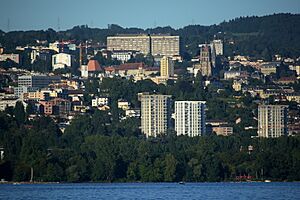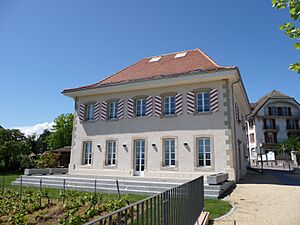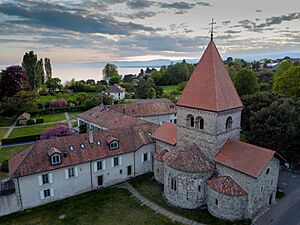Saint-Sulpice, Vaud facts for kids
Quick facts for kids
Saint-Sulpice
|
||
|---|---|---|

Saint-Sulpice
|
||
|
||
| Country | Switzerland | |
| Canton | Vaud | |
| District | Ouest Lausannois | |
| Area | ||
| • Total | 1.86 km2 (0.72 sq mi) | |
| Elevation | 394 m (1,293 ft) | |
| Population
(Dec 2020 )
|
||
| • Total | 4,914 | |
| • Density | 2,642/km2 (6,843/sq mi) | |
| Postal code |
1025
|
|
| Surrounded by | Denges, Écublens, Évian-les-Bains (FR-74), Lausanne, Préverenges, Publier (FR-74) | |
Saint-Sulpice is a lovely town, also called a municipality, in Switzerland. It's in the Vaud area, specifically in the Ouest Lausannois district. Think of it as a close neighbor, or suburb, of the bigger city of Lausanne.
A Look at History
Saint-Sulpice has a long history! It was first written about in the year 1228. Back then, it was called Sanctus Surpiscius.
Where is Saint-Sulpice Located?
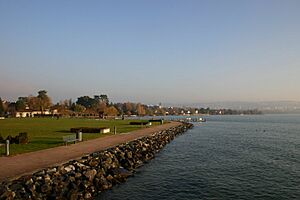
Saint-Sulpice is a small place, covering about 1.9 square kilometers (which is about 0.73 square miles). A good part of this land, about 75.8%, is built up with buildings and roads.
About 15.1% of the land is used for farming. Another 7.0% is covered by forests.
This town is right along the beautiful Lake Geneva. It sits between two rivers, the Venoge and the Chamberonne. Saint-Sulpice includes the main village, a living area called Les Pierrettes, and an industrial zone known as En Champigny.
What Does the Coat of Arms Mean?
The town's coat of arms is red with a silver top part. On it, you can see a silver church outlined in black. This design represents the town's history and its important church.
Who Lives in Saint-Sulpice?
As of 2008, about 27.3% of the people living in Saint-Sulpice were from other countries. Over ten years, from 1999 to 2009, the town's population grew by 4%.
Most people in Saint-Sulpice speak French, about 81.6% of the population. The next most common language is German, spoken by about 7.9% of the people. About 2.8% of the population speaks English.
In 2000, about 12.9% of the people living in Saint-Sulpice were born there. Many others, about 34.8%, were born in the same area (canton). About 29.1% of the residents were born outside of Switzerland.
The town has a mix of age groups. In 2009, about 11.3% of the population were children aged 0-9. Teenagers (10-19 years old) made up about 7.5%. Adults aged 20-59 made up a larger part, and older adults (60 and above) made up about 27.8% of the population.
Most households in Saint-Sulpice have about 2.2 people. About 33.2% of households are made up of just one person. Many families are married couples with or without children.
The number of people living in Saint-Sulpice has changed a lot over time. You can see how the population has grown in the chart below:

Important Buildings and Heritage

The Swiss Reformed Church of Sainte-Marie-Madeleine and its old Priory are very important. They are listed as a special heritage site of national significance in Switzerland.
Sadly, the church's roof had to be rebuilt after a fire in July 2001.
How People Work in Saint-Sulpice
In 2010, the unemployment rate in Saint-Sulpice was 3.8%. This means a small number of people who wanted jobs couldn't find them.
Most people in Saint-Sulpice work in the tertiary sector. This includes jobs like sales, transportation, hotels, restaurants, and healthcare. There are also jobs in the secondary sector, like manufacturing and construction. Only a few jobs are in the primary sector, which is farming or fishing.
Many people who live in Saint-Sulpice travel to other towns for work. Also, some people come into Saint-Sulpice from other places to work. About 15.3% of workers use public transportation, and 66.8% drive their own cars.
Religions in Saint-Sulpice
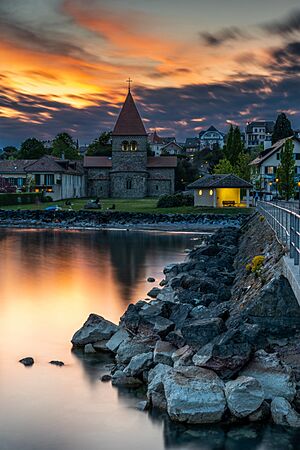
Based on a 2000 survey, about 34.0% of the people in Saint-Sulpice were Roman Catholic. About 40.3% belonged to the Swiss Reformed Church.
There are also smaller groups of people who follow other Christian churches, Jewish faith, and Islamic faith. Some people are Buddhist or Hindu. About 15.65% of the population said they didn't belong to any church or were agnostic or atheist.
Learning and Education
Education is important in Saint-Sulpice. About 34.5% of the people have finished high school, and 31.3% have gone on to higher education, like a university.
In the 2009/2010 school year, there were 226 students in the local school district. Children usually attend four years of primary school and six years of lower secondary school.
Saint-Sulpice is also very close to two major universities: the École Polytechnique Fédérale de Lausanne and the University of Lausanne. These universities have sports facilities and student housing within the Saint-Sulpice area.
Famous People from Saint-Sulpice
One well-known artist from this area was Walter Weibel (1924-2006). He created many sculptures that you can see in public places around Saint-Sulpice. Two famous ones are "Le Pélican" (The Pelican) in Pelican Park and "Le Cri du Poète" (The Poet's Cry) in the port.
See also
 In Spanish: Saint-Sulpice (Vaud) para niños
In Spanish: Saint-Sulpice (Vaud) para niños





